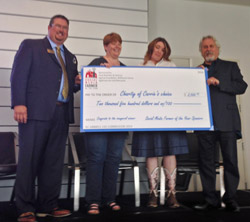
Pictured: Anthem finalists Lindsay Webber and Jessica Ronat, RFD-TV host Rachael Bernard, FMC’s Paul Redhage, Music Producer Tom Davis, finalists Leanna Crawford and Halle Reid
FMC Strategic Communications Manager Paul Redhage says they just got back from Nashville where all four finalists recorded music videos at the famous House of Blues for a program that will air on RFD TV August 28. “Starting that same day, August 28 through September 28, it’s back to on-line voting to determine of those final four who is the grand prize winner,” Redhage said. The first 20 finalists were chosen by on-line voting, and nearly 50,000 votes were cast.
This is the third year for the contest, which Paul says they never expected to be as successful as it has been. “We just knew we wanted to do something for the youth in agriculture,” he said. “It’s grown in numbers of students participating each year and number of states represented.”
The four finalists are Halle Reid from New Mexico, Jessica Ronat from Illinois, and Leanna Crawford and Lindsay Webber, both from the state of Washington.
Find out more about the finalists and the success of FMC’s singing contest in this interview with Paul: Interview with Paul Redhage, FMC
Thanks to FMC for helping us to provide coverage this week of the Farm Progress Show, and make sure to cast your vote for the best Anthem singer, starting August 28.













